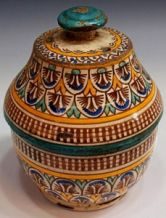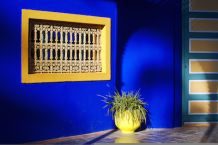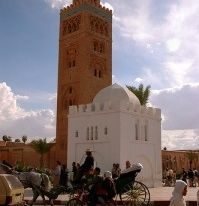
The busy medinas of Morocco with their maze of zig-zagging streets reveal the daily life as it was for Morocco’s jewish population who lived in the mellahs the walled-in old sections of the cities of Rabat, Fez, Marrakech and Casablanca. The daily haggling over food and handicrafts as the Muslim call to prayer echoed from the minarets was the reality for jews for hundreds of years. Jewish tourists come from all over the world to retrace the lives of their ancestors who played such a significant role in Morocco’s history.
Morocco was home to many great Rabbis and Kabbalists including R’Yitzchak Al-Fasi (Rif) (1013-1088), the Rambam (1160-1165), R’ Joseph Gikatila and the Ohr Ha’Chaim Ha’Kadosh (1698-1742).
In the 1492 thousands of Jews were expelled from Spain during the Inquisition. Many came to Morocco bringing their skills and creativity honed by the Andalusian period in Spain which deeply influenced Moroccan art and culture.

A good place to start for reviewing this heritage is the Jewish Museum in Casablanca which covers an area of 700 square meters, is the first of its kind in the Arab world.It contains large multipurpose room, used for exhibitions of painting, photography and sculpture.There are three other rooms, with windows containing exhibits on religious and family life and exhibits on working life and two rooms displaying complete Moroccan synagogues. There are also libraries featuring documents,photgraphs and videos.
A visit to Casablanca’s Jewish Cemetery in the mellah is open and quiet, with well-kept white stone markers in French, Hebrew and Spanish. Once a year, Casablancans celebrate a hiloula, or prayer festival, at the tomb of the Jewish saint, Eliahou.

Casablanca’s 4,500 jewish community live outside the mellah in the European city, where they worship in over 30 synagogues, eat in kosher restaurants, entertain themselves in community centers, and attend Jewish schools and social service centers. Jewish Casablancans worship at Temple Beth El, the largest synagogue and an important community center, seating 500 persons.
Some Jews visit the Muslim shrine of Sidi Belyouteach year, Casablanca’s patron saint. Many Jews of Casablanca celebrate the hiloula of the saint Yahia Lakhdar in Ben Ahmed, about an hour south of Casablanca near the town of Settat.
Fez, the most complete medieval city in the world and home to the Rif (R’ Yitzchak Al-Fasi, 11th Century) and the Rambam (1160–1165). Shopping in its Medieval souks is to dive straight into ancient Morocco’s still living heritage which is also part of Morocco’s Jewish heritage as well.
The Em Ha’Banim and Ibn Danan Synagogues, t the very important large Jewish cemetery, opposite the Royal Palace (where “Solika the Righteous Woman,” the most famous woman in Jewish-Moroccan history, is buried) and the Nejjarine Fountain. We explore one of the most fascinating and famous Souks in the Moslem world with its narrow, medieval, maze-like streets and absorb the mystique of this remarkable eighth-century city, Fez is the most ancient of the Moroccan Imperial cities, founded in 790 by Moulay Idriss II.
Meknes was once an imperial capital with impressive ramparts and had a large Jewish population and Morocco’s modern capital Rabat and Sale have interesting reminders of Jewish culture.
Marrakech, Morocco’s other imperial city has a famous mellah in the medina with its own souk with the famous Slat La’azama Synagogue .The splendid sites of Marrakech; the Badii Palace,the Bahia Palace,the Saadian tombs, the Medersa Ben Youssef and the souks filled with handicrafts and artifacts many of which are directly descended from the work of the jewish craftsmenwho were part ofthe everyday life of the city.
Outside Marrakech in the foothills of the Atlas Mountains in the remote village of Timzerit for eight days during the holiday of Sukkot, Jews from around the world visit this site to honour the memory of one of Morocco’s most famous rabbis. Ironically, Rabbi David U Moshe is, by legend, an Ashkenazi — an emissary from the city of Safed in the Holy Land who came to southern Morocco to raise money from local Jews. When he died suddenly , he was given a Amazigh (Berber) name — “U Moshe” means “son of Moses”.
Also,20 minutes from Marrakech on the Ouarzazate road is the tomb of Moulay Ighi (“Master of Ighi”) which is visited by jews and muslims alike.Other important shrines in the region are Rabbi Raphael HaCohen at Achbarou,Rabbi Shlomo Ben Lhans and Rabbi Shmuel( “Abu Hatzeira”) in Erfoud cemetry. All are places are places of pilgrimagebymuslims and jews alike.
Two hours drive form Marrakech is Essaouira which was once the port of Mogador and became the main port for western imports during the reign of HassanI. This was the period of the cotton trade and Essaouira had a large population engaged in trade, a third of the city was jewish. It is now a vibrant tourist,art and culturalcentre receiving majorfestivals like the Ganoua Music festival each year. It has manymany galleries and craft shops, Essaouira is particularly noted for its wood carving.Its Medina is a UNESCO world heritage site and the synagogue of the venerated Rabbi Chaim Pinto is located in the Mellah.
Ouarzazate has an important mellah close to the souk and superb kasbahs some of which were jewish in the Skoura Oasis 40 kms from Ouarzazate.
For more information about Moroccan Jewish Heritage & a Moroccan Jewish Tour in Casablanca, Morocco






